
The Church of the Holy Trinity is an historic Episcopal church at 381 Main Street in Middletown, Connecticut. Completed in 1874, it is one of the city's finest examples of Gothic Revival architecture. Its nearby former rectory, also known as the Bishop Acheson House, is one of its finest Colonial Revival houses. The two buildings were listed on the National Register of Historic Places in 1979.

The Coite–Hubbard House is a historic house at 269 High Street in Middletown, Connecticut, United States. Built in 1856, it is a prominent local example of high-style Italianate architecture. Since 1904, it has served as the official residence of the president of Wesleyan University. It was listed on the National Register of Historic Places in 1978.

The Edward Augustus Russell House is a Greek Revival house on the Wesleyan University campus in Middletown, Connecticut, USA. The house, at 318 High Street, faces west from the east side of High Street north of the corner at High and Court Streets. A large wooded lawn extends to the Honors College property to the north. High Street between Church and Washington Streets was the most prestigious residential area in Middletown during the 19th century. It was later home to the KNK Fraternity of Wesleyan University. The structural system consists of load-bearing masonry with a flat roof, and materials include brick and flushboarding walls and a brownstone foundation.

The Jacob Pledger House is a historic house at 717 Newfield Street in Middletown, Connecticut. Built in 1803, it is one of only five surviving brick Federal style houses in the city. It was listed on the National Register of Historic Places in 1982. It now houses professional offices.

The Middletown Alms House is a historic building at 53 Warwick Street in Middletown, Connecticut, constructed in 1813–1814. It was originally used as a poorhouse and is the oldest surviving building built for housing the poor in Connecticut, as well as one of the oldest such in the United States. One of the largest structures of the Federal period in Middletown, it was listed on the National Register of Historic Places in 1982.

The Nehemiah Hubbard House is a historic house at the corner of Laurel Grove and Wadsworth Street, Middletown, Connecticut. Built in 1745, it is a center-chimney colonial style house built of clapboard siding and brownstone foundation with wood shingle roof; using a structural system of wood frame, post and beam with gable roof. It was built as a residence which is its current use.
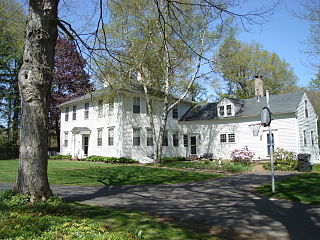
The Plumb House is a historic house at 872 Westfield Street in Middletown, Connecticut, USA. It was built in 1804 by James Plumb, and is exceptionally well preserved. It was listed on the National Register of Historic Places in 1978.

St. Luke's Home for Destitute and Aged Women was incorporated by an act of the Connecticut State Assembly on June 22, 1865. For twenty-seven years the home was conducted in an old house on the southwest corner of Court and Pearl Street. in 1892 a large legacy enabled a new home to be erected at the present site at Pearl and Lincoln Streets. Comfortable quarters are provided for fourteen women. Members of the Church of the Holy Trinity played a large part in establishing the endowment; frequently the current rector of that church serves as president of the Board of Trustees.

The Samuel Russell House is a neoclassical house at 350 High Street in Middletown, Connecticut, built in 1828 to a design by architect Ithiel Town. Many architectural historians consider it to be one of the finest Greek Revival mansions in the northeastern United States. Town's client was Samuel Russell (1789-1862), the founder of Russell & Company, the largest and most important American firm to do business in the China trade in the 19th century, and whose fortunes were primarily based on smuggling illegal and addictive opium into China.

The Seth Wetmore House is a residence built in the Center-Hall Colonial style in 1746 at 1066 Washington Street, Middletown, Connecticut. It was built of Clapboard siding, Brownstone foundation with asphalt shingle roof using a structural system of wood frame, post and beam with gable roof. It was added to the National Register of Historic Places on September 10, 1970.
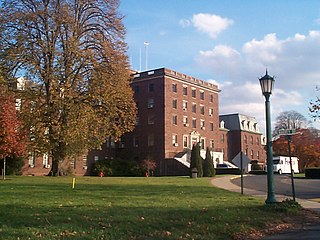
Connecticut Valley Hospital in Middletown, Connecticut, is a public hospital operated by the state of Connecticut to treat people with mental illness. It was historically known as Connecticut General Hospital for the Insane. It is a 100-acre (40 ha) historic district that was listed on the National Register of Historic Places in 1985.
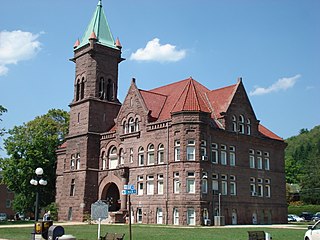
The Barbour County Courthouse in Philippi, Barbour County, West Virginia, USA is a monumental public building constructed between 1903 and 1905 in the Richardsonian Romanesque style. It dominates the town center and is the county's chief symbol of government. It was added to the National Register of Historic Places in 1980.

The Wadsworth Mansion at Long Hill Estate is located at 421 Wadsworth Street in Middletown, Connecticut. It is a 16,000-square-foot (1,500 m2) classical revival house situated on 103 acres (0.42 km2) wooded area. It is currently owned by the City of Middletown and is operated by the Long Hill Estate Authority. The mansion is the centerpiece of the Wadsworth Estate Historic District of 270 acres (1.1 km2), which includes the mansion's associated outbuildings, the Middletown portion of Wadsworth Falls State Park, the Nehemiah Hubbard House, and several barns and farmhouses along Laurel Grove Road such as the Harriet Cooper Lane House.
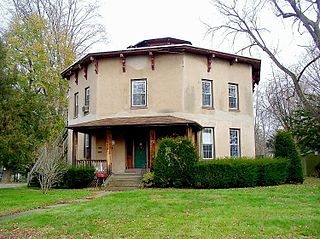
The Joseph Williams Octagon House and the Gilbert Stancliff Octagon House are once-identical historic mid-1850s octagon houses located next to each other at 26 and 28 Marlborough Street in Portland, Connecticut. Constructed of Portland brownstone in the 1850s, they are distinctive as the only known pair of little-altered octagon houses in the state. The pair of houses, also known as the Octagon House Pair, was added to the National Register of Historic Places in 1976.

The Rocky Hill Congregational Church is a historic church at 805-817 Old Main Street in Rocky Hill, Connecticut, USA. Built in 1808 for a 1723 congregation, it is a distinctive late example of Georgian architecture, and a prominent landmark in the town center. The building was listed on the National Register of Historic Places in 1982.

The Telephone Exchange Building is a historic building at 23 Union Street in downtown Norwich, Connecticut, behind Norwich Town Hall. Built in 1906-07, it was the first purpose-built telephone exchange building in the city, and is a little-altered example of period exchanges built by the Southern New England Telephone Company. The building now houses city offices. It was listed on the National Register of Historic Places on November 28, 1983.
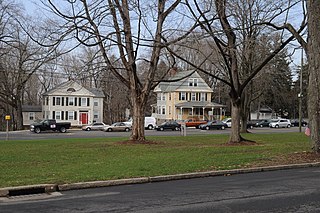
The Washington Street Historic District encompasses a residential area of Middletown, Connecticut that has a long history as a fashionable and desirable neighborhood. Extending along Washington Street and Washington Terrace between Main and Jackson Streets, the area has a broad diversity of residential architecture dating from 1752 to 1931, reflecting the city's patterns of growth. The district was listed on the National Register of Historic Places in 1985.
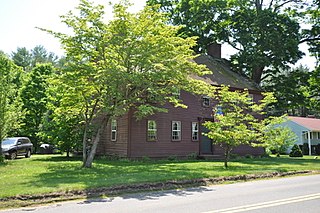
1010 Shuttle Meadow Road is a historic house at 1010 Shuttle Meadow Road in Southington, Connecticut. Built about 1772, it is one of the town's few surviving 18th-century houses. It was listed on the National Register of Historic Places in 1989.

The Roswell Moore II House is a historic house at 1166 Andrews Street in Southington, Connecticut. Built around 1787, it is one of a small number of surviving 18th-century houses in the town, and is a well-preserved example of Georgian architecture. It was listed on the National Register of Historic Places in 2005.

The Ezekiel Woodruff House is a historic house at 1152 East Street in Southington, Connecticut., Built in the mid-to-late 18th-century, it is a well-preserved example of a Georgian Cape style house. It was listed on the National Register of Historic Places in 1989.






















